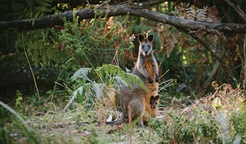Wooloondool campground
Murrumbidgee Valley Regional Park
Learn more
Learn more about why this park is special
Wooloondool campground is in Murrumbidgee Valley Regional Park. Here are just some of the reasons why this park is special:
Aboriginal culture

The river red gums have been important to Wiradjuri people, the traditional owners of the Murrumbidgee Valley, for thousands of years. Used for making canoes and shields, they also provide warmth, shelter and food. Some river red gums were large enough for individuals to sleep in, and light a small fire during the cold nights. Even today, Wiradjuri artists in Narrandera use river red gum to make boomerangs, coolamons and carved didgeridoos.
Take me to the river

Murrumbidgee River flows in a westerly direction and is over 1,600km long. River red gums benefit from times of flooding as it recharges the subsoil with water. The river supports river red gums forests, which in turn support the banks of the river with their root systems. Logged since the 1820s and managed as forests by the government since the early 1900s, in 2010 NSW National Parks and Wildlife Service protected 107,000ha of river red gums by creating new parks and reserves, which will now be enjoyed for generations to come.
River red gums

The Murrumbidgee Valley River parks protect part of the longest continuous tract of river red gum forest in the world. An iconic Australian eucalypt which grows to awe-inspiring heights with a deep red colour curving along rivers and channels, the Riverina river red gum is of international significance.
Plants and animals protected in this park
Animals
-

Swamp wallaby (Wallabia bicolor)
The swamp wallaby, also known as the black wallaby or black pademelon, lives in the dense understorey of rainforests, woodlands and dry sclerophyll forest along eastern Australia. This unique Australian macropod has a dark black-grey coat with a distinctive light-coloured cheek stripe.
-

Tawny frogmouth (Podargus strigoides)
Found throughout Australia, the tawny frogmouth is often mistaken for an owl due to its wide, powerful beak, large head and nocturnal hunting habits. The ‘oom oom oom’ call of this native bird can be heard echoing throughout a range of habitats including heath, woodlands and urban areas.
-

Southern boobook (Ninox novaeseelandiae)
The southern boobook, also known as the mopoke, is the smallest and most common native owl in Australia. With a musical 'boo-book' call that echoes through forests and woodlands, the southern boobook is a great one to look out for while bird watching.
Plants
-

Saltbush (Atriplex nummularia)
A hardy Australian native plant, the saltbush is a small spreading shrub that can withstand dry salty soils such as those found in the desert plains of western NSW. It is grey-white in colour and has small spear-shaped succulent leaves. It flowers from December to April.
-

River red gum (Eucalpytus camaldulensis)
Australian native plants, majestic river red gum trees are widespread across Australian inland river systems. The river red gum is a dominant tree species of the Murray-Darling basin which spans NSW, Queensland and Victoria. This iconic native eucalypt grows to a height of 30m and is thought to have a lifespan up to 500-1000 years.
Look out for...
Swamp wallaby
Wallabia bicolor

The swamp wallaby, also known as the black wallaby or black pademelon, lives in the dense understorey of rainforests, woodlands and dry sclerophyll forest along eastern Australia. This unique Australian macropod has a dark black-grey coat with a distinctive light-coloured cheek stripe.
